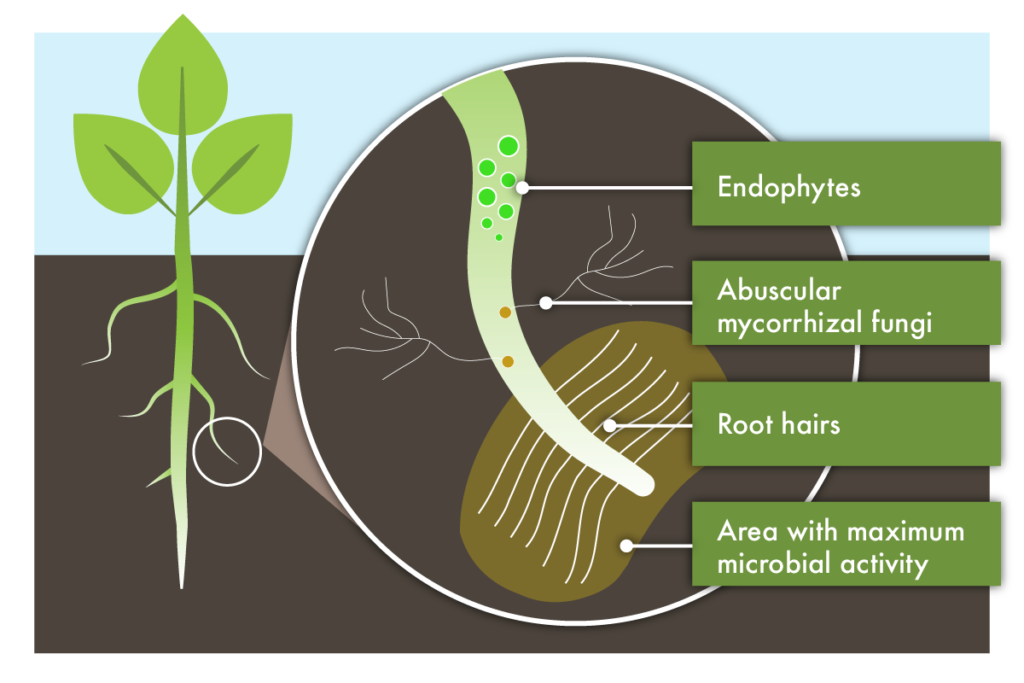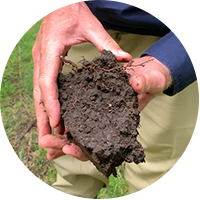Bioguide #2
How soil microbes improve plant health
Exploring the dynamic relationship between soil microbes and plants, and why healthy plants start with biologically active soil.
 Plants grow in soil, which is a complex and dynamic combination of soil microbes and soil chemistry.
Plants grow in soil, which is a complex and dynamic combination of soil microbes and soil chemistry.
Plants are the food source for soil microbes. The highest number of soil microbes can be found around the roots of plants (the rhizosphere) – in particular, the root hairs within 1cm of the root tip, where there can be 1,000 times more microbes than in soil without roots. These root hairs take up both water and nutrients into the plant. To do this, plants release exudates (a mixture of plant carbohydrates, amino acids, proteins and lipids) from the root hairs in order to capture (chelate) minerals to make them absorbable. Soil microbes live off these exudates as well as breaking down the sloughed off (old) root hairs as the root continues to grow and explores more of the soil. Via this process, soil microbes (both bacteria and fungi) are essential for plant growth.
Soil microbes have a wide range of effects, both direct and indirect, on plants and overall soil biology:
- Provide plant nutrients – Soil bacteria make nitrogen (N), phosphorous (P) and sulphur (S) available for plants. N, P and S fertilisers are “locked up” by the soil in chemical forms that are stable in the soil soon after application but are not available to the plant until bacterial “mineralisation activity” takes place. Mycorrhizal fungi in particular, provides the plant with carbohydrates and nutrients such as phosphorous and zinc.
- Enhance root growth – Some soil bacteria have evolved to produce plant rooting hormones which cause the plant to grow more roots, supporting plant and other microbial populations to develop.
- Extend the plant root system – Arbuscular mycorrhizal fungi mycelia act like a secondary root structure allowing the plant to mine a larger volume of soil to obtain more nutrients. This adds to plant resilience during drought, as the plant can scavenge for more water, and in times of flood and waterlogging, buffering the plant against excess moisture.
- Improve soil structure – Mycorrhizal fungi aggregate (or cluster) soil particles together by producing a protein called glomalin. This improved aggregation encourages root penetration through the soil. Land management practices such as ploughing, particularly around plant roots, break these mycelia which reduces the benefits of mycorrhizal fungi.
- Suppress disease – in diseased soil, the balance between bacteria and fungal populations needs to be restored and an increase in good bacteria can compete with the disease-causing microbes to recreate a healthy balance.
- Stimulate the plant’s defence system (ISR or induced-systemic resistance) – some bacteria and fungi stimulate the plant’s defence system, supporting the plant to be more resilient against attacks from pathogens.
- Produce antibiotics – some bacteria (actinomycetes) produce antibiotics that kill off other pathogenic microbes.
- Decompose organic matter – some soil microbes break down lignified plant cell walls and green organic matter with low carbon:nitrogen ratios (e.g. lawn clippings) into humus.
Microbes populations inside plants (called endophytes) also have a range of effects:
- Fix nitrogen – some bacteria (Rhizobium species) live inside plant roots and convert atmospheric nitrogen to plant-available nitrogen.
- Stimulate the plant defence system – some fungi (Neotyphodium species) are able to protect grasses from insect attacks and assist in protection from environmental stresses e.g. drought.
Evidence
 |
Improve soil biology in your kiwifruit orchard This flyer details the results of long-term trials conducted in Bay of Plenty kiwifruit orchards using Mycorrcin, Foliacin, and Digester, and concludes that the resulting improvements in soil biology led to higher vine yields and better-quality fruit. Read more |
Ready to get started?
Check out our range of products dedicated to soil health:

